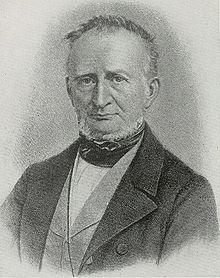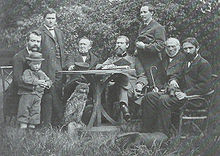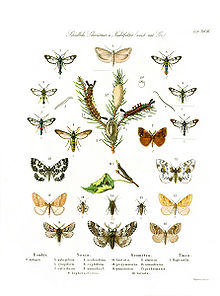
Julius Theodor Christian Ratzeburg
Encyclopedia

Berlin
Berlin is the capital city of Germany and is one of the 16 states of Germany. With a population of 3.45 million people, Berlin is Germany's largest city. It is the second most populous city proper and the seventh most populous urban area in the European Union...
– 24 October 1871) was a German
Germany
Germany , officially the Federal Republic of Germany , is a federal parliamentary republic in Europe. The country consists of 16 states while the capital and largest city is Berlin. Germany covers an area of 357,021 km2 and has a largely temperate seasonal climate...
zoologist
Zoology
Zoology |zoölogy]]), is the branch of biology that relates to the animal kingdom, including the structure, embryology, evolution, classification, habits, and distribution of all animals, both living and extinct...
, botanist
Botany
Botany, plant science, or plant biology is a branch of biology that involves the scientific study of plant life. Traditionally, botany also included the study of fungi, algae and viruses...
, entomologist
Entomology
Entomology is the scientific study of insects, a branch of arthropodology...
, and forester
Forestry
Forestry is the interdisciplinary profession embracing the science, art, and craft of creating, managing, using, and conserving forests and associated resources in a sustainable manner to meet desired goals, needs, and values for human benefit. Forestry is practiced in plantations and natural stands...
.
Biography
Ratzeburg, the son of a professor at the veterinary school of the University of BerlinHumboldt University of Berlin
The Humboldt University of Berlin is Berlin's oldest university, founded in 1810 as the University of Berlin by the liberal Prussian educational reformer and linguist Wilhelm von Humboldt, whose university model has strongly influenced other European and Western universities...
, was born in Berlin
Berlin
Berlin is the capital city of Germany and is one of the 16 states of Germany. With a population of 3.45 million people, Berlin is Germany's largest city. It is the second most populous city proper and the seventh most populous urban area in the European Union...
. He studied medicine
Medicine
Medicine is the science and art of healing. It encompasses a variety of health care practices evolved to maintain and restore health by the prevention and treatment of illness....
and natural sciences in Berlin and was principally interested in botany. He became a private lecturer at the University of Berlin in 1828. At this time, Ratzeburg was in contact with Alexander
Alexander von Humboldt
Friedrich Wilhelm Heinrich Alexander Freiherr von Humboldt was a German naturalist and explorer, and the younger brother of the Prussian minister, philosopher and linguist Wilhelm von Humboldt...
and Wilhelm von Humboldt
Wilhelm von Humboldt
Friedrich Wilhelm Christian Karl Ferdinand Freiherr von Humboldt was a German philosopher, government functionary, diplomat, and founder of Humboldt Universität. He is especially remembered as a linguist who made important contributions to the philosophy of language and to the theory and practice...
. Two years later, when the Berlin Forestry School moved to Eberswalde
Eberswalde
Eberswalde is a major town and the administrative seat of the district Barnim in the German Federal State of Brandenburg, about 50 km northeast of Berlin. Population 42144 , geographical location . The town is often called Waldstadt , because of the large forests around it, including the...
, he became professor of natural history
Natural history
Natural history is the scientific research of plants or animals, leaning more towards observational rather than experimental methods of study, and encompasses more research published in magazines than in academic journals. Grouped among the natural sciences, natural history is the systematic study...
there at the invitation of Friedrich Wilhelm Leopold Pfeil (1783-1859). He founded the botanic garden of forestry at Eberswalde, working there until his retirement in 1869. He returned to Berlin where he died aged 70 years.
Ratzeburg was the author of important works on forestry and forest entomology, and he is considered the founder of the latter discipline. He was notably interested in parasitic species
Parasitism
Parasitism is a type of symbiotic relationship between organisms of different species where one organism, the parasite, benefits at the expense of the other, the host. Traditionally parasite referred to organisms with lifestages that needed more than one host . These are now called macroparasites...
. From 1827 to 1834 he wrote with Johann Friedrich von Brandt
Johann Friedrich von Brandt
Johann Friedrich von Brandt was a German naturalist.Brandt was born in Jüterbog and educated at a gymnasium in Wittenberg and the University of Berlin. In 1831 he was appointed director of the Zoological Department at the St Petersburg Academy of Sciences, where he published in Russian...
Medizinische Zoologie (or Medical zoology), which was a standard work for many years.

Entomological works
- Die Forstinsekten, Berlin 1837–1844, three volumes and a supplement.; réédition at Vienna 1885.
- Die Waldverderber und ihre Feinde, Berlin, 1841, 8th réédition of Johann Friedrich Judeich (1828-1894) and Hinrich Nitsche (1845-1902) under the title Lehrbuch der mitteleuropäischen Insektenkunde, Vienne, 1885, with a biography.
- Die Ichneumonen der Forstinsekten, Berlin 1844–1852, three volumes.
The parts are:-
- Ratzeburg, J.T.C. 1844 (March 31), Die Ichneumonen der Forstinsekten in entomologischer und forstlicher Beziehung 1:224pp, 4 plates Berlin. download http://www.nhm.ac.uk/perthMedia/chalcidoids/pdf/Ratzeb844.pdf
- Ratzeburg, J.T.C. 1844 (August 31), Die Ichneumonen der Forstinsekten in entomologischer und forstlicher Beziehung 3:viii+314pp, 16 plates Berlin downloadhttp://www.nhm.ac.uk/perthMedia/chalcidoids/pdf/Ratzeb844b.pdftitle
- Ratzeburg, J.T.C. 1848, Die Ichneumonen der Forstinsekten in entomologischer und forstlicher Beziehung 2:vi+238pp, 4 tables, 3 plates Berlin down load http://www.nhm.ac.uk/perthMedia/chalcidoids/pdf/Ratzeb848.pdf
- Ratzeburg, J.T.C. 1852, Die Ichneumonen der Forstinsekten in entomologischer und forstlicher Beziehung 3:v-xviii+272pp, 3 tables Berlin
- Die Nachkrankheiten und die Reproduktion der Kiefer nach dem Fraß der Forleule, Berlin, 1862.
- Die Waldverderbnis oder dauernder Schaden, welcher durch Insektenfraß, Schälen etc. an lebenden Waldbäumen entsteht, Berlin, 1866–1868, two volumes.

Other subjects
- Medizinische Zoologie, avec Brandt, Berlin, 1827–1834, two volumes.
- Abbildung und Beschreibung der in Deutschland wild wachsenden Giftgewächse, with Brandt and Philipp Phöbus (1804-1880), Berlin 1834; new edition in 1838.
- Forstnaturwissenschaftliche Reisen, Berlin 1842.
- Die Standortsgewächse und Unkräuter Deutschlands, Berlin 1859.
- Forstwissenschaftliches Schriftstellerlexikon, Berlin 1872–1873.

